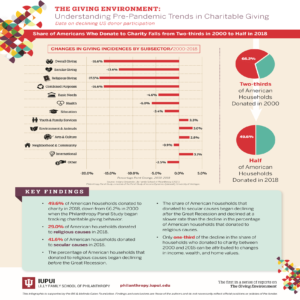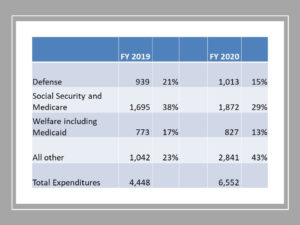Marty Levine
7/29/21
Recently Indiana University’s Lilly Family School of Philanthropy published its review of long-term trends in our nation’s charitable giving, “The Giving Environment”. Analyzing data from four separate donor surveys, its authors were able to look to identify a long-term trend that adds to the concern about philanthropy and raises an important warning about our turning to philanthropy in our search for social equity.
“For the first time since the Philanthropy Panel Study (PPS) began tracking the share of American households who donated to charity in a given year, the participation rate has dropped to half. In 2018, 49.6 percent of American households donated to charity, according to the PPS data, down from 66.2 percent of American households donating in 2000 when the PPS began tracking. Declines in the giving rate occurred among almost all socio-demographic groups, including by race, age, income, and education level.”
Because total philanthropy from all sources has been increasing it has been easy to look away from the shrinking number of individual donors. As Fortune Magazine, using data reported in the 2020 edition of Giving USA, recently described it “Americans gave more to charity last year than in 2019, despite an economic downturn that disrupted the paychecks of millions. Faced with greater needs, estates and foundations also opened up their pocketbooks at increased levels—resulting in a 5.1% spike in total giving from the $448 billion recorded for 2019, or a 3.8% jump when adjusted for inflation.”
And this is not just true because Foundations and Corporations have been making up for individual givers. In 2018, The Lilly Family School found that “individuals donated $306 billion, the second-highest amount donated by individuals up to that point in the midst of a global pandemic, economic recession, and increased attention paid to social and racial justice issues, giving by individuals reached a new high in 2020 at $324 billion.”
At a moment when the nation’s social safety net has been tested the question of where responsibility should lie for addressing chronic and emergency economic distress is front and center. As those who struggled before COVID arrived were joined millions more who were thrown into jeopardy by the economic pandemic-caused economic slowdown it was all too clear that private generosity would not be able to meet the growing need. Only a governmental response would be able to be large enough and strong enough to protect those at risk.
Individual giving can be directed to a wide range of activities, from museums to universities, from libraries to homeless shelters and hospitals. The impact of the ongoing pandemic has strained the nonprofit community. It has both made it more expensive to serve their audiences and, significantly for organizations serving those facing economic hardship increased the demand for their services. Because the nonprofit community is an important and active partner with the government to provide the vital safety net that those at risk rely on, we cannot ignore how strongly these past months have demonstrated the reality that philanthropy cannot stand alone.

Private charity is just not up to the task of creating a robust safety net. The resources are too small. As impressive as it is that annual giving exceeds $400 billion and that, of this total, individual gifts comprise more than $200 billion those sums dim when we consider how large the need is. In a year that the need to protect so many from grave economic threats, threats that meant tens of millions struggled to keep paying their rent and feeding their families, that limitation is highlighted when we recognize that only about 21% of total individual giving flows to social service and health organization. In its base budget, the Federal Government budgets more than $800 billion for similar purposes. In face of the recent crisis, it was only the Federal Government and not private philanthropy that was able to raise its support in line with the rapidly increasing need.

As we see conditions improving and our lives returning to “normal”, we are again hearing arguments that normalcy should not include a continuing role for government as the primary support for a robust social safety net. They remain fixed in a mindset that private troubles are best cured by private charity. The words of Mark Rosenman, published in the Chronicles of Philanthropy in 2006, capture the premise of their argument. “Some conservatives have begun to again argue that government should no longer provide for essential social services. They say that charity can be an adequate and acceptable substitute for government in meeting needs and resolving social problems.”
A loss of a collective commitment to our collective well-being that comes along with any shrinkage in the government’s safety net role is only made worse by the shrinking number of donors, by a concentration of giving in a smaller number of hands. I’ve written recently about the growing wave of mega-giving coming from a new generation of wealthy men and women. The size, and often the purpose, are impressive but they are marked by their individualism.
The shrinking pool of donors is also a wealthier group of donors. “Nearly eight out of 10 households with more than $200,000 of wealth gave to charity in 2018, the study said. By contrast, fewer than four in 10 households with wealth less than $50,000 made donations.” The result, often labeled “Dollars Up, Donors Down, “does not bode well.
John List, an economics professor at the University of Chicago who studies giving captured the meaning of this change in comments reported by The Chronicle of Philanthropy:
“The overall pie [in giving] is slowly moving towards the ultra-wealthy. Rich people give to causes that rich people want to give to. You have a very different supply of goods and services from the charitable community when the rich people give versus when the middle-class or lower-class gives.”
The current reality of more money from fewer donors has been why total charitable giving in the United States has continued to increase according to Giving USA. If Government is kept at bay in the face of great human need, then it gives too much power to the voices of a small slice of our society. While mega-donors like McKenzie Scott and the Walton Family share an ability to make huge donations and a desire, even with very different perspectives, to control when and how their charity is realized. How they give reflects their personal vision and has little communal direction They can change course as their personal tastes change and they have no ongoing responsibility to fulfill any collective commitment. They are disconnected from the work of our democratically created government.
Only government can build the enduring and comprehensive safety net that ensures the welfare of all, a lesson we should have learned from our recent painful COVID months. The gridlock that is fueled by those who remain convinced, in the face of all we have now seen, that helping those in need is just a private matter cannot be allowed to stand.

3 Responses
[…] week I questioned whether private philanthropy was able to handle the pressing societal challenges we face. A study […]
[…] am worried that in allowing the charitable urges of the most wealthy among us to become the nation’s social […]
[…] 2021, amidst the economic and human destruction that the COVID pandemic had caused, I observed that “Private charity is just not up to the task of creating a robust safety net. The resources […]